Pine: Difference between revisions
ClueBot NG (talk | contribs) m Reverting possible vandalism by 2.98.255.191 to version by Pinethicket. False positive? Report it. Thanks, ClueBot NG. (1545204) (Bot) |
|||
| Line 57: | Line 57: | ||
===Cones=== |
===Cones=== |
||
Pines are mostly [[Plant sexuality|monoecious]], having the male and female [[Conifer cone|cones]] on the same tree, though a few species are [[Plant sexuality|sub-dioecious]] with individuals predominantly, but not wholly, single-sex. The male cones are small, typically 1–5 cm long, and only present for a short period (usually in spring, though autumn in a few pines), falling as soon as they have shed their [[pollen]]. The female cones take 1.5–3 years (depending on species) to mature after [[pollination]], with actual fertilization delayed one year. At maturity the female cones are 3–60 cm long. Each cone has numerous spirally arranged scales, with two seeds on each fertile scale; the scales at the base and tip of the cone are small and sterile, without seeds. The seeds are mostly small and winged, and are anemophilous (wind-dispersed), but some are larger and have only a vestigial wing, and are [[bird]]-dispersed (see below). At maturity, the cones usually open to release the seeds, but in some of the bird-dispersed species (e.g. [[Whitebark Pine]]), the seeds are only released by the bird breaking the cones open. In others, the seeds are stored in closed ("serotinous") cones for many years until an environmental cue triggers the cones to open, releasing the seeds. The most common form of serotiny is pyriscence, in which a resin binds the cones cones shut until melted by a forest fire. |
|||
a cone is a condom that can hold and produce seeds |
|||
==Ecology== |
==Ecology== |
||
Revision as of 19:08, 6 March 2013
This article needs additional citations for verification. (December 2011) |
| Pine tree | |
|---|---|
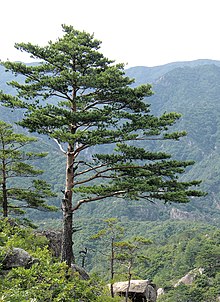
| |
| Japanese Red Pine (Pinus densiflora), North Korea | |
| Scientific classification | |
| Kingdom: | |
| Division: | |
| Class: | |
| Order: | |
| Family: | |
| Genus: | Pinus |
| Subgenera | |
See Pinus classification for complete taxonomy to species level. See list of pines by region for list of species by geographical distribution. | |
Pines are trees in the genus Pinus (/[invalid input: 'icon']ˈpaɪnəs/),[1] in the family Pinaceae. They make up the monotypic subfamily Pinoideae. There are about 115 species of pine, although different authorities accept between 105 and 125 species.
Etymology
The modern English name pine derives from Latin pinus which some have traced to the Indo-European base *pīt- ‘resin’ (source of English pituitary.[2] In the past (pre-19th century) they were often known as fir, from Old Norse fyrre, by way of Middle English firre. The Old Norse name is still used for pines in some modern north European languages, in Danish, fyr, in Norwegian fura/fure/furu, Swedish, fura/furu, and Föhre in German, but in modern English, fir is now restricted to Fir (Abies) and Douglas-fir (Pseudotsuga).
Taxonomy, nomenclature and codification
Pines are divided into three subgenera, based on cone, seed and leaf characters:
- Pinus subg. Pinus, the yellow or hard pine group
- Pinus subg. Ducampopinus, the foxtail or pinyon group
- Pinus subg. Strobus, the white or soft pine groups
Distribution


Pines are native to most of the Northern Hemisphere, and have been introduced throughout most temperate and subtropical regions of the world, where they are grown as timber and cultivated as ornamental plants in parks and gardens. One species (Sumatran Pine) crosses the equator in Sumatra to 2°S. In North America, they range from 66°N to 12°N. A number of introduced species have become invasive,[3] threatening native ecosystems.
Morphology

Pines are evergreen, coniferous resinous trees (or rarely shrubs) growing 3–80 m tall, with the majority of species reaching 15–45 m tall. The smallest are Siberian Dwarf Pine and Potosi Pinyon, and the tallest is a 268.35-foot (81.79-meter) tall Ponderosa Pine located in southern Oregon's Rogue River-Siskiyou National Forest.[4]
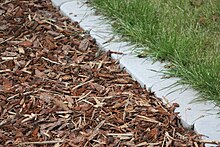
The bark of most pines is thick and scaly, but some species have thin, flaking bark. The branches are produced in regular "pseudo whorls", actually a very tight spiral but appearing like a ring of branches arising from the same point. Many pines are uninodal, producing just one such whorl of branches each year, from buds at the tip of the year's new shoot, but others are multinodal, producing two or more whorls of branches per year. The spiral growth of branches, needles, and cone scales are arranged in Fibonacci number ratios.[citation needed] The new spring shoots are sometimes called "candles"; they are covered in brown or whitish bud scales and point upward at first, then later turn green and spread outward. These "candles" offer foresters a means to evaluate fertility of the soil and vigour of the trees.
Pines are long-lived, typically reaching ages of 100–1,000 years, some even more. The longest-lived is the Great Basin Bristlecone Pine, Pinus longaeva. One individual of this species, dubbed Methuselah, is one of the world's oldest living organisms at around 4,600 years old. This tree can be found in the White Mountains of California.[5] An older tree, unfortunately now cut down, was dated at 4,900 years old. It was discovered in a grove beneath Wheeler Peak and it is now known as Prometheus after the Greek immortal.[citation needed]
Foliage
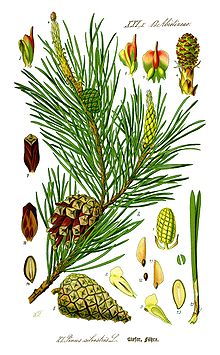
Pines have four types of leaf:
- Seed leaves (cotyledons) on seedlings, borne in a whorl of 4–24.
- Juvenile leaves, which follow immediately on seedlings and young plants, 2–6 cm long, single, green or often blue-green, and arranged spirally on the shoot. These are produced for six months to five years, rarely longer.
- Scale leaves, similar to bud scales, small, brown and non-photosynthetic, and arranged spirally like the juvenile leaves.
- Needles, the adult leaves, which are green (photosynthetic), bundled in clusters (fascicles) of 1–6, commonly 2–5, needles together, each fascicle produced from a small bud on a dwarf shoot in the axil of a scale leaf. These bud scales often remain on the fascicle as a basal sheath. The needles persist for 1.5–40 years, depending on species. If a shoot is damaged (e.g. eaten by an animal), the needle fascicles just below the damage will generate a bud which can then replace the lost leaves.
Cones
a cone is a condom that can hold and produce seeds
Ecology
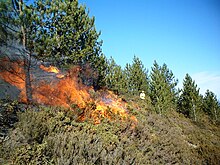
Pines grow well in acid soils, some also on calcareous soils; most require good soil drainage, preferring sandy soils, but a few (e.g. Lodgepole Pine) will tolerate poorly drained wet soils. A few are able to sprout after forest fires (e.g. Canary Island Pine). Some species of pines (e.g. Bishop Pine) need fire to regenerate, and their populations slowly decline under fire suppression regimes. Several species are adapted to extreme conditions imposed by elevation and latitude (e.g. Siberian Dwarf Pine, Mountain Pine, Whitebark Pine and the bristlecone pines). The pinyon pines and a number of others, notably Turkish Pine and Gray Pine, are particularly well adapted to growth in hot, dry semi-desert climates.[citation needed]
The seeds are commonly eaten by birds and squirrels. Some birds, notably the Spotted Nutcracker, Clark's Nutcracker and Pinyon Jay, are of importance in distributing pine seeds to new areas. Pine needles are sometimes eaten by some Lepidoptera (butterfly and moth) species (see list of Lepidoptera that feed on pines), the Symphytan species Pine sawfly, and goats.
Uses
This section needs additional citations for verification. (December 2011) |

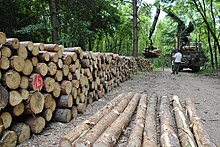
Pines are among the most commercially important of tree species, valued for their timber and wood pulp throughout the world. In temperate and tropical regions, they are fast-growing softwoods that will grow in relatively dense stands, their acidic decaying needles inhibiting the sprouting of competing hardwoods. Commercial pines are grown in plantations for timber that is denser, more resinous, and therefore more durable than spruce (Picea). Pine wood is widely used in high-value carpentry items such as furniture, window frames, panelling, floors and roofing, and the resin of some species is an important source of turpentine.
Many pine species make attractive ornamental plantings for parks and larger gardens, with a variety of dwarf cultivars being suitable for smaller spaces. Pines are also commercially grown and harvested for Christmas trees. Pine cones, the largest and most durable of all conifer cones, are craft favorites. Pine boughs, appreciated especially in wintertime for their pleasant smell and greenery, are popularly cut for decorations. A number of species are attacked by nematodes, causing pine wilt disease, which can kill some quickly. Pine needles are also used for making decorative articles like baskets, trays, pots, etc. This Native American skill is now being replicated across the world. Pine needle handicrafts are made in the US, Canada, Mexico, Nicaragua and India. Pine needles serve as food for various Lepidoptera. See List of Lepidoptera which feed on Pines.
Because pines have no insect or decay resistant qualities after logging, they are generally recommended for construction purposes as indoor use only (ex. indoor drywall framing). This wood left outside can be expected to last no more than 12–18 months depending on the type of climate it is exposed to. It is commonly referred to by several different names which include North American timber, SPF (spruce, pine, fir) and whitewood.
Food uses

Some species have large seeds, called pine nuts, that are harvested and sold for cooking and baking.
The soft, moist, white inner bark (cambium) found clinging to the woody outer bark is edible and very high in vitamins A and C. It can be eaten raw in slices as a snack or dried and ground up into a powder for use as an ersatz flour or thickener in stews, soups, and other foods, such as bark bread. Adirondack Indians got their name from the Mohawk Indian word atirú:taks, meaning "tree eaters".
A tea made by steeping young, green pine needles in boiling water (known as "tallstrunt" in Sweden) is high in vitamins A and C.
See also
Notes
- ^ Sunset Western Garden Book, 1995:606–607
- ^ pine. (2006). In Word Origins. Retrieved from http://www.credoreference.com/entry/acbwordorig/pine
- ^ "Pinus ssp. (tree), General Impact". Global Invasive Species Database. Invasive Species Specialist Group. 13 March 2006. Retrieved 2 March 2011.
- ^ Fattig, Paul (2011-01-23). "Tallest of the tall". Mail Tribune. Medford, Oregon. Retrieved 2011-01-27.
- ^ Ryan, Michael (1999). "The Complete Pine". BioScience. 49 (12): 1023–1024.
{{cite journal}}:|access-date=requires|url=(help); Check date values in:|accessdate=(help); Unknown parameter|coauthors=ignored (|author=suggested) (help); Unknown parameter|month=ignored (help)
References
- Farjon, A. 1984, 2nd edition 2005. Pines. E. J. Brill, Leiden. ISBN 90-04-13916-8
- Little, E. L., Jr., and Critchfield, W. B. 1969. Subdivisions of the Genus Pinus (Pines). US Department of Agriculture Misc. Publ. 1144 (Superintendent of Documents Number: A 1.38:1144).
- Richardson, D. M. (ed.). 1998. Ecology and Biogeography of Pinus. Cambridge University Press, Cambridge. 530 p. ISBN 0-521-55176-5
- Sulavik, Stephen B. 2007. Adirondack; Of Indians and Mountains, 1535-1838. Purple Mountain Press, Fleischmanns, NY. 244 p. ISBN 1-930098-79-0 ISBN 978-1-930098-79-4
- Mirov, N. T. 1967. The Genus Pinus. Ronald Press, New York (out of print).
- Classification of pines
- Gymnosperm Database - Pinus
Bibliography
- Attention: This template ({{cite doi}}) is deprecated. To cite the publication identified by doi:10.1146/annurev.pp.10.060159.001255, please use {{cite journal}} (if it was published in a bona fide academic journal, otherwise {{cite report}} with
|doi=10.1146/annurev.pp.10.060159.001255instead. - Philips, Roger. Trees of North America and Europe, Random House, Inc., New York ISBN 0-394-50259-0, 1979.
